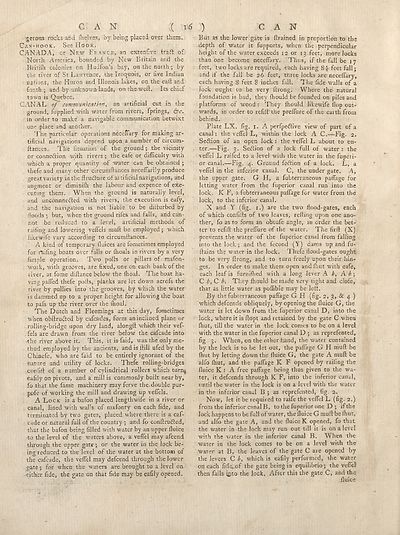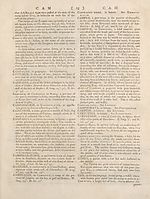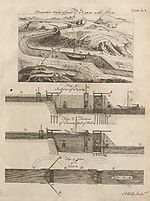Encyclopaedia Britannica; or, A dictionary of arts and sciences, compiled upon a new plan … > Volume 2, C-L
(26) Page 16
Download files
Complete book:
Individual page:
Thumbnail gallery: Grid view | List view

CAN ’( 16
'gerous rocks and flielves, by being placed over them.
Cav-hook. See Hook.
CANADA, or New France, an extenflve tradl of
North America, bounded by New Britain and the
Britifli colonies on Hudfon’s bay, on the north ; by
the river of St Lawrence, the Iroquois, or five Indian
nations, the Huron and Illonois lakes, on the call and
fouth ; and by unknown lands, on the weft. Its chief
town is Quebec.
CANAL e/' communication, an artificial cut in the
ground, fupplied with water from rivers, fprings, <bc.
in order to make a navigable communication betwixt
one place and another.
The particular operations necefiary for making ar¬
tificial navigations depend upon a number of circum-
ftances. The fuuation of the ground; the vicinity
or connection with rivers ; the eafe or difficulty with
which a proper quantity of water can be obtained ;
thefe and many other circumftances neceflarily produce
great variety in the ftruCture of artificial navigations, and
augment or diminiffi the labour and expence of exe¬
cuting them. When the ground is naturally level,
and unconnneCted with rivers, the execution is eafy,
and the navigation is not liable to be difturbed by
floods ; but, when the ground rifes and falls, and can¬
not be reduced to a level, artificial methods of
railing and lowering veffels muft be employed; which
likewife vary according to circumftances.
A kind of temporary Unices are fometimes employed
for raffing boats over falls or ffioals in rivers by a very
fimple operation. Two polls or pillars of mafon-
work, with grooves, are fixed, one on each bank of the
river, at fome diftance below the ffioal. The boat ha¬
ving palfed thefe polls, planks are let down acrofs the
river by pullies into the grooves, by which the water
is dammed up to a proper height for allowing theffioat
to pafs up the river over the ffioal.
The Dutch and Fleemings at this day, fometimes
when obllruCled by cafcades, form an inclined plane or
rolling-bridge upon dry land, along!! which their vef¬
fels are drawn from the river below the cafcade into
-the river above it. This, it is faid, was the only me¬
thod employed by the ancients, and is ftili ufed by the
Chinefe, who are faid to be entirely ignorant of the
nature and utility of locks. Thefe rolling-bridges
confift of a number of cylindrical rollers which turn|
ealily on pivots, and a mill is commonly built near by,
fo that the fame machinery may ferve the double pur-
pofe of working the mill and drawing up veffels.
A Lock is a bafon placed length wife in a river or
canal, lined with walls of mafonry on each fide, and
terminated by two gates, placed where there is a caf¬
cade or natural fall of the country ; and fo conftrudled,
that the bafon being filled with water by an upper fluice
to the level of the waters above, a veffel may afcend
through the upper gate; or the water in the lock be¬
ing reduced to the level of the water at the bottom of
the cafcade, the veflel may defcend through the lower
gate; for when the waters are brought to a level on
either fide, the gate on that fide may be eafily opened.
) CAN
But as the lower gate is ftrained in proportion to the
depth of water it fupports, when the perpendicular
height of the water exceeds 12 or 13 feet, more locks
than one become neceffary. Thus, if the fall be ] 7
feet, two locks are required, each having 8|- feet fall;
and if the fall be 26 feet, tnree locks are neceflary,
each having 8 feet 8 inches fall. The fide-walls of a
lock ought to be very ftrong. Where the natural
foundation is bad, they ffiould be founded on piles and
platforms of wood: They ffiould likewife llop out¬
wards, in order to refill'the prelfure of the earth from
behind.
Plate LX. fig. i. A perfpedtive view of part of a
canal: the veflel L, within the lock A C.—Fig. 2.
Sedlion of an open lock : the veflel L about to en¬
ter.—Fig. 3. Sedlion of a lock full of water : the
veffel L raifed to a level with the water in the fupert-
or canal.—Fig. 4. Ground feftion of a lock. L, a
veflel in the inferior canal. C, the under gate. A,
the upper gate. G H, a fubterraneous paflage for
letting water from the fuperior canal run into the
lock. K F, a fubterraneous paflage for water from the
lock, to the inferior canal.
X and Y (fig. 1.) are the two flood-gates, each
of which confifts of two leaves, relting upon one ano¬
ther, fo as to form an obtufe angle, in order the bet¬
ter to refill the preflure of the water. The firft (X)
prevents the water of the fuperior canal from falling
into the lock ;, and the fecond (Y) dams up and fu-
llains the water in the lock. Thefc flood-gates ought
to be very Itrong, and to turn freely upon their.hin¬
ges. In order to make them open and Unit with eafe,
each leaf is furniflied with a long lever A b, A b;
C C L They ffiould be made very tight and dole,
that as little water as poflible may be loft.
By the fubterraneous paflage G H (fig. 2, 3, & 4 )
which defeends obliquely, by opening the lluice G, the
water is let down from the fuperior canal D, into the
lock, where it is ftopt and retained by the gate C when
ffiut, till the water in the lock comes to be on a level
with the water in the fuperior canal D ; as reprefented,
fig 3. When, on the other hand, the water contained
by the lock is to be let out, the paffitge G H muft be
ffiut by letting down the lluice G, the gate A muft be
alfo ffiut, and the paflage K F opened by railing the
fluice K : A free paflage being thus given to the wa¬
ter, it defeends through K F, into the inferior canal,
until the water in the lock is on a level with the water
in the inferior canal B ; as reprefented, fig. 2.
Now, let it be required to raife the veflel L (fig. 2.)
from the inferior canal B, to the fuperior one D ; ifthe
lock happens to be full of water, the fluice G muftbe ffiut,
and alfo the gate A, and the fluice K opened, fo that
the water in the lock may run out till it is on a level
with the water in the inferior canal B. When the
water in the lock comes to be on a level with the
water at B, the leaves of the gate C are opened by
the levers C b, which is eafily performed, the water
on each fide^of the gate being in equilibrio; the vefl'el
then fails veto the lock. After this the gate C, and the
fluice
'gerous rocks and flielves, by being placed over them.
Cav-hook. See Hook.
CANADA, or New France, an extenflve tradl of
North America, bounded by New Britain and the
Britifli colonies on Hudfon’s bay, on the north ; by
the river of St Lawrence, the Iroquois, or five Indian
nations, the Huron and Illonois lakes, on the call and
fouth ; and by unknown lands, on the weft. Its chief
town is Quebec.
CANAL e/' communication, an artificial cut in the
ground, fupplied with water from rivers, fprings, <bc.
in order to make a navigable communication betwixt
one place and another.
The particular operations necefiary for making ar¬
tificial navigations depend upon a number of circum-
ftances. The fuuation of the ground; the vicinity
or connection with rivers ; the eafe or difficulty with
which a proper quantity of water can be obtained ;
thefe and many other circumftances neceflarily produce
great variety in the ftruCture of artificial navigations, and
augment or diminiffi the labour and expence of exe¬
cuting them. When the ground is naturally level,
and unconnneCted with rivers, the execution is eafy,
and the navigation is not liable to be difturbed by
floods ; but, when the ground rifes and falls, and can¬
not be reduced to a level, artificial methods of
railing and lowering veffels muft be employed; which
likewife vary according to circumftances.
A kind of temporary Unices are fometimes employed
for raffing boats over falls or ffioals in rivers by a very
fimple operation. Two polls or pillars of mafon-
work, with grooves, are fixed, one on each bank of the
river, at fome diftance below the ffioal. The boat ha¬
ving palfed thefe polls, planks are let down acrofs the
river by pullies into the grooves, by which the water
is dammed up to a proper height for allowing theffioat
to pafs up the river over the ffioal.
The Dutch and Fleemings at this day, fometimes
when obllruCled by cafcades, form an inclined plane or
rolling-bridge upon dry land, along!! which their vef¬
fels are drawn from the river below the cafcade into
-the river above it. This, it is faid, was the only me¬
thod employed by the ancients, and is ftili ufed by the
Chinefe, who are faid to be entirely ignorant of the
nature and utility of locks. Thefe rolling-bridges
confift of a number of cylindrical rollers which turn|
ealily on pivots, and a mill is commonly built near by,
fo that the fame machinery may ferve the double pur-
pofe of working the mill and drawing up veffels.
A Lock is a bafon placed length wife in a river or
canal, lined with walls of mafonry on each fide, and
terminated by two gates, placed where there is a caf¬
cade or natural fall of the country ; and fo conftrudled,
that the bafon being filled with water by an upper fluice
to the level of the waters above, a veffel may afcend
through the upper gate; or the water in the lock be¬
ing reduced to the level of the water at the bottom of
the cafcade, the veflel may defcend through the lower
gate; for when the waters are brought to a level on
either fide, the gate on that fide may be eafily opened.
) CAN
But as the lower gate is ftrained in proportion to the
depth of water it fupports, when the perpendicular
height of the water exceeds 12 or 13 feet, more locks
than one become neceffary. Thus, if the fall be ] 7
feet, two locks are required, each having 8|- feet fall;
and if the fall be 26 feet, tnree locks are neceflary,
each having 8 feet 8 inches fall. The fide-walls of a
lock ought to be very ftrong. Where the natural
foundation is bad, they ffiould be founded on piles and
platforms of wood: They ffiould likewife llop out¬
wards, in order to refill'the prelfure of the earth from
behind.
Plate LX. fig. i. A perfpedtive view of part of a
canal: the veflel L, within the lock A C.—Fig. 2.
Sedlion of an open lock : the veflel L about to en¬
ter.—Fig. 3. Sedlion of a lock full of water : the
veffel L raifed to a level with the water in the fupert-
or canal.—Fig. 4. Ground feftion of a lock. L, a
veflel in the inferior canal. C, the under gate. A,
the upper gate. G H, a fubterraneous paflage for
letting water from the fuperior canal run into the
lock. K F, a fubterraneous paflage for water from the
lock, to the inferior canal.
X and Y (fig. 1.) are the two flood-gates, each
of which confifts of two leaves, relting upon one ano¬
ther, fo as to form an obtufe angle, in order the bet¬
ter to refill the preflure of the water. The firft (X)
prevents the water of the fuperior canal from falling
into the lock ;, and the fecond (Y) dams up and fu-
llains the water in the lock. Thefc flood-gates ought
to be very Itrong, and to turn freely upon their.hin¬
ges. In order to make them open and Unit with eafe,
each leaf is furniflied with a long lever A b, A b;
C C L They ffiould be made very tight and dole,
that as little water as poflible may be loft.
By the fubterraneous paflage G H (fig. 2, 3, & 4 )
which defeends obliquely, by opening the lluice G, the
water is let down from the fuperior canal D, into the
lock, where it is ftopt and retained by the gate C when
ffiut, till the water in the lock comes to be on a level
with the water in the fuperior canal D ; as reprefented,
fig 3. When, on the other hand, the water contained
by the lock is to be let out, the paffitge G H muft be
ffiut by letting down the lluice G, the gate A muft be
alfo ffiut, and the paflage K F opened by railing the
fluice K : A free paflage being thus given to the wa¬
ter, it defeends through K F, into the inferior canal,
until the water in the lock is on a level with the water
in the inferior canal B ; as reprefented, fig. 2.
Now, let it be required to raife the veflel L (fig. 2.)
from the inferior canal B, to the fuperior one D ; ifthe
lock happens to be full of water, the fluice G muftbe ffiut,
and alfo the gate A, and the fluice K opened, fo that
the water in the lock may run out till it is on a level
with the water in the inferior canal B. When the
water in the lock comes to be on a level with the
water at B, the leaves of the gate C are opened by
the levers C b, which is eafily performed, the water
on each fide^of the gate being in equilibrio; the vefl'el
then fails veto the lock. After this the gate C, and the
fluice
Set display mode to:
![]() Universal Viewer |
Universal Viewer | ![]() Mirador |
Large image | Transcription
Mirador |
Large image | Transcription
Images and transcriptions on this page, including medium image downloads, may be used under the Creative Commons Attribution 4.0 International Licence unless otherwise stated. ![]()
| Encyclopaedia Britannica > Encyclopaedia Britannica; or, A dictionary of arts and sciences, compiled upon a new plan … > Volume 2, C-L > (26) Page 16 |
|---|
| Permanent URL | https://digital.nls.uk/144913936 |
|---|
| Attribution and copyright: |
|
|---|
| Description | Ten editions of 'Encyclopaedia Britannica', issued from 1768-1903, in 231 volumes. Originally issued in 100 weekly parts (3 volumes) between 1768 and 1771 by publishers: Colin Macfarquhar and Andrew Bell (Edinburgh); editor: William Smellie: engraver: Andrew Bell. Expanded editions in the 19th century featured more volumes and contributions from leading experts in their fields. Managed and published in Edinburgh up to the 9th edition (25 volumes, from 1875-1889); the 10th edition (1902-1903) re-issued the 9th edition, with 11 supplementary volumes. |
|---|---|
| Additional NLS resources: |
|

